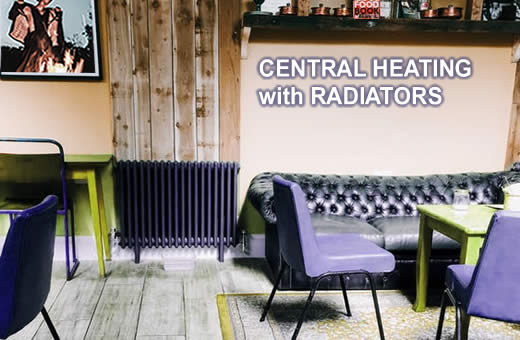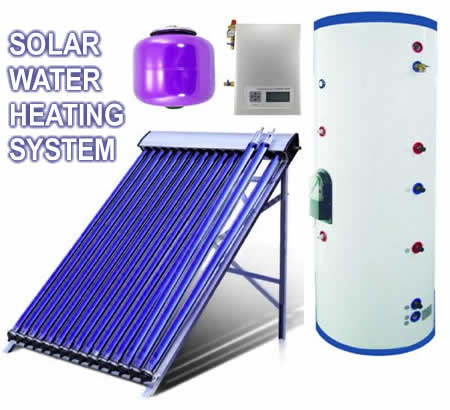Heating
In this section of the website I have added a lot of useful information on heating solutions for the home, the office and the workplace where you want to be comfortable in a warm, pleasant interior atmosphere.
There are plenty of reasons why you might need to know about the many different ways of keeping yourself warm at home and where you work during the colder months of the year and this is a great place to make some startling discoveries.
Primary Heating System
Of course depending upon where you live, chances are you already have a primary system for keeping your office or home warm in winter. For most people it will do its job day in and day out and when it's working flawlessly you wouldn't give it a second thought.
 But what about those times when it doesn't work, for whatever reason?
But what about those times when it doesn't work, for whatever reason?
It could be that components have broken or worn out and have to be fixed or replaced. Or it could be the system has grown old, unreliable and needs replacing altogether.
Having to pay for a new heating installation is a big financial burden that no one wants in their lives. This is especially so when your home budget is already stretched to the limit or your business is only just seeing a marginal profit.
It can be a real burden when the budget simply won't stretch to having to pay a substantial bill. It can be a real headache if it means the possibility of having to take out a loan to cover the costs and all the stressful financial implications that go with it.
Shopping Around for the Best Value
In such a case it certainly pays to shop around to see where you can get the best deal on the purchase and installation costs of replacing your heating setup. There are many companies out there that want your business and are willing to broker a good deal to get it.
Cheaper alternatives exist such as finding a company that will sell you a system while allowing you to engage your own skilled labor to install it. This can work when you are lucky enough to have a family member or close friend in that line of work that can fit it for you more cheaply.
Failing that possibility, you can also shop around for service engineers to give you quotes to undergo the installation. Then you can decide on which one is most affordable assuming the firm comes with some recommendations from past customers that you can often find online.
Heating Options
There are several options for providing the necessary warmth in your home or place of work, so let's take a brief look at what those options might be.
Central Heating Systems
 By far the most popular kind of heating solution in colder climates is a central system that provides warmth by running a central boiler or furnace that heats water and feeds it to radiators installed in each room of the house. The furnace or boiler can be powered by a number of different burnable fuels, such as gas, oil or wood or it can be electrically powered.
By far the most popular kind of heating solution in colder climates is a central system that provides warmth by running a central boiler or furnace that heats water and feeds it to radiators installed in each room of the house. The furnace or boiler can be powered by a number of different burnable fuels, such as gas, oil or wood or it can be electrically powered.
This type of system once installed is relatively simple to operate, generally being controlled by a central thermostat and a timer for the boiler to fire up at set times during the day or when the internal temperature drops below a preset threshold.
Off Peak Electric Storage Heaters
There are electrically powered storage heaters that heat up overnight to take advantage of cheaper ″off-peak″ electricity tariffs (where this is applicable) that literally store up the heat when power is billed at a cheaper rate and then release that heat slowly throughout the rest of the day.
It really depends on your whether low tariff or off-peak electricity is offered in your local area for this solution to be economical, but when it is, it is possible to heat a home or office using cheap rate electricity and save money during the cold period.
Distributed Heaters
Another common method of providing heat in a home or office building is to use individual heaters in each room. There are several alternative types of individual heater that is suitable for buildings located in particular areas where certain fuels are abundant or cheap.
Traditional Fireplace
 A traditional wood or coal burning fireplace in each room is a commonly seen feature in older buildings. These ″fires″ burn solid fuel locally sourced and can work out to be cheaper than using electrically powered heaters where, for example firewood is in abundance and cheap to have delivered or even free to harvest if you happen to live in or close to a forest.
A traditional wood or coal burning fireplace in each room is a commonly seen feature in older buildings. These ″fires″ burn solid fuel locally sourced and can work out to be cheaper than using electrically powered heaters where, for example firewood is in abundance and cheap to have delivered or even free to harvest if you happen to live in or close to a forest.
Coal or smokeless coke is another solid heating fuel option for open fireplaces, although this can be more costly and require ample storage space in the home.
Fireplaces are particularly inefficient heat sources as a good percentage of the heat generated in the fire is lost up the chimney with only a small proportion of the heat actually radiating into the room.
Natural Gas Heaters
A common replacement for an open fire in a hearth is a professionally installed natural gas heater. This type of heater burns natural gas, piped into the building from a local network as its fuel. This is more common in city locations where there is an established natural gas infrastructure in place.
The unburned exhaust gases are sent up an existing chimney opening through a flue, which is essentially a metallic pipe connected to the heater and fed up through the chimney and secures at the top. Flues need to be checked periodically to ensure there are no leaks to prevent dangerous carbon monoxide (and other noxious) gas from seeping into the room.
Electric Space Heaters
 For a completely ″clean″ and relatively safe means of heating a room, an electric space heater is a great solution if you don't want the hassle of using a solid fuel burning fire or the potential dangers of burning natural gas as a fuel.
For a completely ″clean″ and relatively safe means of heating a room, an electric space heater is a great solution if you don't want the hassle of using a solid fuel burning fire or the potential dangers of burning natural gas as a fuel.
Electric heaters come in a large variety of designs, from real fire emulating units, to radiant heaters, oil-filled electric radiators, convention heaters and fan heaters that blow hot air into the room.
The main downside to electric heaters is the cost of running them. A typical electric free standing heater uses between 1-3kW or energy, which can soon elevate the level of energy consumed day to day.
Portable Propane Heaters
For a completely portable heating solution, there are a number of portable heaters of varying sizes and outputs that use propane as their fuel. These are often used as emergency heaters that are brought into service during power outages or to augment the heating output of existing heat sources in a building during severe cold weather.
Propane is readily available to buy in cannisters in local hardware stores or at gas stations so you can keep a supply in your garage at home and always have that option if needed.
Kerosene and Parraffin Heaters
Also, there are paraffin or kerosene fuelled portable heaters available that are useful as a backup heat source where that fuel is locally available. These heaters are not as safe or clean to use as propane devices, but nevertheless they exist and can be useful where no other alternative is available.
Solar Heating
 Lastly, an off-grid environmentally friendly alternative exists in solar powered heat sources. These generally require your home to be suitably situated for installing the sun-powered collectors.
Lastly, an off-grid environmentally friendly alternative exists in solar powered heat sources. These generally require your home to be suitably situated for installing the sun-powered collectors.
The sun's energy is used to heat water in specially designed collectors that are often mounted on the roof or suitable area that gets unshaded sun exposure during the day. The heated water is then pumped into a storage tank where it can be used for hot water or, in larger installations to heat radiators in a similar way a central heating system works.
The only limitation to this kind of solution is that the sun's heat is only available during the day as long as it's not cloudy. It also takes time for the water to heat up in the collectors and to achieve a large enough volume of hot water in storage.
So efficient storage is essential for this form of heat source to work in a domestic situation and to provide sufficient overnight and early morning warmth when needed. This kind of solution is generally not suitable for city dwellers as ample roof space can be a limitation especially for apartment block dwellers where the available roof space per dwelling is usually very small.
Power Outage Contingency
Another side of staying warm in winter is not so much the reliability of your main system, but whether it relies on the electricity supply to either power it directly or to power the controls that keep it running when using a different fuel source. When the power goes out as it seems to do more and more often these days, do you have a contingency heating solution in place?
Because if there is no power to run your controller, thermostat or timer, for example, you could find yourself without heat on very cold days (and nights). If you can't get your system running when there is no electricity, you will need to have some backup heaters to put into service so you can keep working in comfort.
These alternatives are covered in the articles in this section as well as the provision of reviews of certain models that we can recommend as being perfect for certain tasks.
Office Heating Related Articles and Review Pages
If you want to get more information, there is a great selection of heating related articles and review document listed below:

